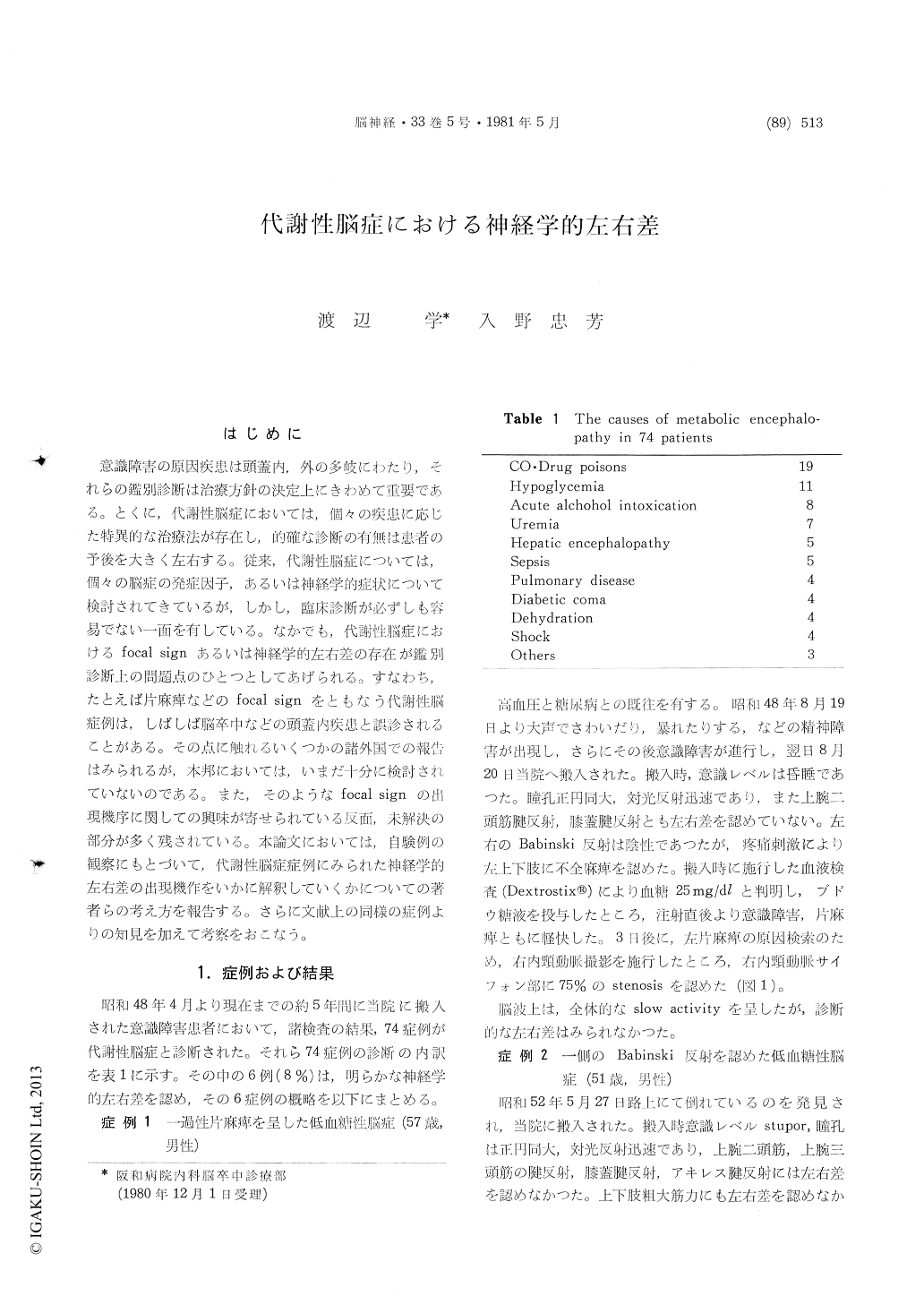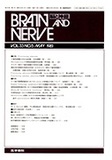Japanese
English
- 有料閲覧
- Abstract 文献概要
- 1ページ目 Look Inside
はじめに
意識障害の原因疾患は頭蓋内,外の多岐にわたり,それらの鑑別診断は治療方針の決定上にきわめて重要である。とくに,代謝性脳症においては,個々の疾患に応じた特異的な治療法が存在し,的確な診断の有無は患者の予後を大きく左右する。従来,代謝性脳症については,個々の脳症の発症因子,あるいは神経学的症状について検討されてきているが,しかし,臨床診断が必ずしも容易でない一面を有している。なかでも,代謝性脳症におけるfocal signあるいは神経学的左右差の存在が鑑別診断上の問題点のひとつとしてあげられる。すなわち,たとえば片麻痺などのfocal signをともなう代謝性脳症例は,しばしば脳卒中などの頭蓋内疾患と誤診されることがある。その点に触れるいくつかの諸外国での報告はみられるが,本邦においては,いまだ十分に検討されていないのである。また,そのようなfocal signの出現機序に関しての興味が寄せられている反面,未解決の部分が多く残されている。本論文においては,自験例の観察にもとづいて,代謝性脳症症例にみられた神経学的左右差の出現機作をいかに解釈していくかについての著者らの考え方を報告する。さらに文献上の同様の症例よりの知見を加えて考察をおこなう。
The development of focal neurological sign in patients suffering from metabolic encephalopathy constitutes an important diagnostic and therapeutic problem. In this paper, clinical and neuroradio-logical findings were observed to investigate the pathogenesis of development of several focal neu-rological signs in metabolic encephalopathy.
Six patients of metabolic encephalopathy showing neurological laterallity were selected for the present study. The diagnosis of these patients were uremia(1 case), nonketotic hyperosmolar diabetic como (2 cases), hypoglycemia (2 cases) and hypothermia (1 case). The neurological laterallity observed in these patients on admission were hemiparesis (4 cases), conjugate deviation (1 case) or unilateral Babinski reflex (1 case).
Cerebral angiographies were performed in four cases. In one case diagnosed as having hypogly-cemia with left hemiparesis had about 75% stenosis in syphon portion of the right internal carotid artery. In the other three cases no abnormality was found by cerebral angiographies. CT scan was performed in four cases. In two cases low density area suggesting the occurrence of previous cerebral infarction was found. No abnormality was found in the other two cases. It can be summarized that in two of six cases neither cerebral angiography nor CT scan could reveal the abnormal findings contributing to the development of focal neurolo-gical signs. In one case having hypothermia with hemiparesis no diagnostic abnormality was found despite careful postmortem examination.
The present study suggests that the neuroradio-logically demonstrable vascular or brain changes of the local brain may contribute to the develop. ment of several focal signs in some, not all, cases of metabolic encephalopathy. The classification of the factors for the development of focal neurologi-cal signs in metabolic encephalopathy can be recommended as follows: (1) Preictal factor: The causal region of focal neurological signs existing before the occurrence of metabolic encephathy. The region may be silent or overt symptomatically. The example of the silent one is a clinically latent occlusive region of cerebral vessel. The example of the overt one is the existence of old infarction or of intracranial bleeding developing prior to the metabolic encephalopathy. (2) Postictal factor: The focal cerebral damage such as infarction or hemorrhage develops following metabolic disorder in some cases. This is explained by the fact that several risk factors are common to cerebrovascular disease and metabolic encephalopathy, i.e., disorder of blood coagulation in hepatic coma, hemocon-solidation in diabetic coma. (3) Undetermined type: Sometimes it is difficult to know clinically whether the focal signs follow the onset of metabolic dis-der or the metabolic disorder follows focal signs. As for the cases reported in this paper, two cases were judged as those of (1) preictal factor, one case (2) postictal factor and three cases (3) undeter-mined type.

Copyright © 1981, Igaku-Shoin Ltd. All rights reserved.


